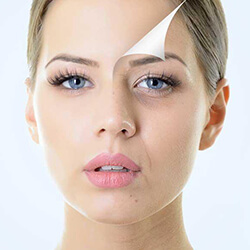
Newer Peels
The most effective peel used for treatment of acne and pimples is Black peel. It helps to reduce acne at the back of the shoulders in a single session. The Cosmelan peel is widely used for control of pigmentation and melasma. It works based on a combination between a peel and home care cream which results in improvement in pigmentation and texture of skin.
Combination Peels
Combination peel is a combination of two or more chemical peels which complement each other. The presence of two agents deliver better results than that of a single agent. Combination peels are more effective than regular peels because of the synergic nature of treating active agents. It is best recommended in the treatment for skin conditions like acne, acne scars, pigmentation due to acne etc.
Glycolic Acid Peels
Glycolic Acid peel is a chemical peel in which the main content is Glycolic content. Glycolic acid is a fruit derived from sugarcane juice. Glycolic peel is used to treat acne, and lighten acne scars.
Lactic Acid Peels
The main component in Lactic Acid Peel is Lactic acid which is derived from sour milk. Lactic Acid peel is the best medicine in the treatment of dry and dull skin.
Salicylic Acid Peels
In Salicylic Acid Peel, the main component is Salicylic acid. It is derived from the bark of a willow tree. Salicylic acid is recommended in the treatment for pimples, acne and oily skin. It helps in the reduction of excess oil thus giving a smooth look to your skin.
Vitamin Peels
Two of the most important Vitamin peels are Vitamin A and Vitamin C peel. Vitamin A peel is used in the treatment of pigmentation, ageing changes or acne induced pigmentation. Vitamin peels tighten the skin, renews the epidermal skin cells, helping to lift pigmentation.
A chemical peel is a simple procedure to rejuvenate and treat many common skin conditions. In this treatment, a chemical agent of known concentration is applied to the skin to be treated for a fixed duration. This causes a controlled exfoliation of the outermost layers of the skin, which in turn stimulates new skin production. The new skin is smoother, brighter and less wrinkled than the older skin. (histopath pic of peel)
Most chemical agents used in peels have been originally discovered in fruits, they are called hydroxy acids. For example, the commonly used glycolic peel finds its origin in Sugarcane juice, Lactic acid from milk or sour curd (hence Cleopatra’s milk bath was actually a chemical peel treatment!). Scientists have isolated and perfected the correct concentrations of the peeling agent in these, and we now benefit from the same.
Chemical peels can be used to treat acne and acne induced scarring and pigmentation. They can also address tanning and sun induced damage to the skin. Chemical peels can be used to rejuvenate fine lines and dark circles around the eyes and mouth. Skin that is dull in texture can be brought back to its normal texture with peeling treatments.
Chemical peels can be performed to treat skin over the face, the delicate areas around the eyes, neck, back, arms and the hands. In fact, any part of the skin can be treated with chemical peels.(before after pics)
A chemical peel is a simple procedure that can be performed as an out patient procedure in the dermatologists office. You may be instructed to avoid using strong creams (like retinoid creams) one to two days before the peel.
On the day of the chemical peel, usually a consultation with the dermatologist is scheduled. After consultation with the dermatologist in order to ascertain your skin type, and the correct concentration and chemical peeling agent to be used, a informed consent is taken. Pre procedure photographs are taken. The skin is cleansed with a soap free cleanser. Then, the peeling agent is applied to the skin by the dermatologist. The peeling agent is left on for a predetermined time (usually 5-10 mins) and neutralised thereafter. During the procedure, most patients experience a mild warmth or mild stinging sensation. A post peel balm and sunscreen are then applied. (video of a peel)
Chemical peels are divided as superficial, medium and deep. Superficial and medium depth peels are usually used commonly in India, as our skin tends to do well with these.
Newer peels have combinations of two or more agents, which tend to enhance the action of the others, giving results from even the first session. Designer peels tending to single problem areas are now being designed for the discerning patient. (link to other peels)
Most patients experience a minimal redness and dryness after the peel which last from a couple of hours to about a day. If a stronger peeling agent has been used, you may experience persistent dryness and exfoliation of the skin which lasts upto five days. Rarely, brown scabs may form, which usually resolve with moisturisation. (peeling after a mid level peel)
Most chemical peels need to be repeated at fortnightly or monthly intervals to give their best results. The result of a single peel may be disappointing, however, even a single peel allows the home care to penetrate the skin better, allowing better results over all. (before after pics)
Yes, chemical peels are often combined with other procedures such as Microdermabrasion, Fractional laser resurfacing, Neurotoxins and fillers to offer cost effective and customised treatments to address needs of the individual patients.
To know more about chemical peels, consult Dr. Rasya Dixit today.